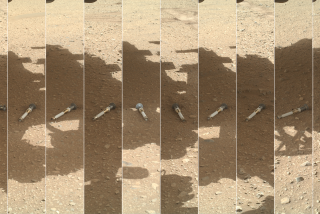House Panel OKs Cuts in Stealth Research
- Share via
WASHINGTON — A House subcommittee dealt a potentially damaging blow to the B-2 stealth bomber Thursday, voting to cut $300 million in research funds from the program only weeks before the plane is to make its first test flight.
In an 11-7 vote of the House Armed Services Committee’s research and development subcommittee, the lawmakers agreed to use the B-2 funds to restore the Marine Corps’ controversial V-22 tilt-rotor aircraft, which the Pentagon had cut in a major cost-savings drive.
Rep. Curt Weldon (R-Pa.), who led the effort, said that, when the full House committee meets to consider the 1990 defense budget next Tuesday, he will seek to restore $300 million to the bomber research fund. But he said he would do that by proposing to transfer that sum from funds requested for production of the plane.
Budget Approved Earlier
On Tuesday, the procurement subcommittee of the Armed Services Committee voted to approve the Bush Administration’s $69-billion defense procurement budget without any changes, leaving funding for the B-2 stealth bomber intact.
If adopted by the full committee, and then by the House and Senate, Weldon’s proposal would in effect slice a little more than 10% from the Bush Administration’s $2.7-billion request for production of the B-2 in 1990.
Although budget requests for the plane remain classified, informed sources said that the Pentagon is seeking $2 billion in 1990 for research and development of the craft.
“I think there’s more than enough in the procurement account,” Weldon said. “We haven’t even flown it yet. Let’s keep the research and development at the full effort and, on the procurement side, let’s just slow it down. That’s not an overwhelmingly large amount of money.”
But the program escaped far deeper cuts in Thursday’s votes, as the panel rejected efforts to kill all development funds. Rep. Ronald V. Dellums (D-Berkeley), chairman of the subcommittee, said that he would lead an effort to terminate the bomber program entirely. Dellums voted against Weldon’s proposal Thursday.
“They’re just trying to cripple (the B-2 program) and use it as a bill-payer” for other programs, said Rep. John R. Kasich (R-Ohio), an Armed Services Committee member who joined forces with Dellums in an effort to kill the program. “My interest is in ending the program. If you cripple it and don’t kill it, all you’re doing is driving up the cost. I say: ‘Look, let’s fish or cut bait now.’ ”
Defense Secretary Dick Cheney, testifying before a Senate subcommittee Thursday, reasserted the Administration’s support for the bomber, whose cost is expected to soar to well over $500 million a copy.
“I have been convinced . . . that we have in fact come upon an enormously significant new capability,” Cheney told the Senate Appropriations Committee’s defense subcommittee. “It is a revolutionary development in aviation,” he added.
The Air Force already has spent almost $20 billion to develop the bomber, a “flying wing” that is designed to penetrate Soviet airspace by eluding radar detection. Sources said that Northrop Corp. has nearly completed construction of a fifth copy of the plane. Pentagon officials said that the long-delayed first flight of the aircraft is expected to occur in the next several weeks.
More to Read
Get the L.A. Times Politics newsletter
Deeply reported insights into legislation, politics and policy from Sacramento, Washington and beyond. In your inbox twice per week.
You may occasionally receive promotional content from the Los Angeles Times.











